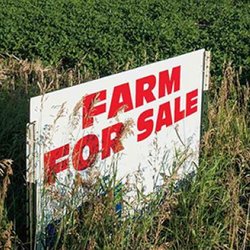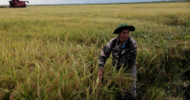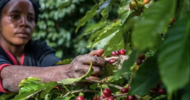Successful Farming | 5 Feb 2018
The Major Players in Agri-Finance
By Shawn Williamson
A few years ago an accountant I know told me about some of her clients. They were a couple of guys on a mission to assemble hundreds of millions of dollars of U.S. farmland for a Canadian pension fund. That’s when I started to realize there’s a lot more going on in the world of agri-finance than you hear about. Here are some of the big players in the agri-finance universe.
The types of players include banks that specialize in agricultural loans, nonbank finance companies that do land and equipment loans, farmer-owned lending co-ops, REITs that own and manage farm real estate, private equity funds that buy cropland, sovereign wealth funds, and, of course, pension funds.
One of the big agri-finance players, Rabo AgriFinance in Chesterfield, Missouri, is headquartered only half an hour from my office. I recently sat down with their executive vice president, Curt Hudnutt, to talk about their market share in ag lending and the overall condition of agricultural loans. Rabo makes land, operating, and equipment loans. The company also sells crop insurance and offers commodity price hedging.
One of my goals was to show you the five largest agricultural lenders in the United States. Sounds easy, right? It isn’t. You have to pull together data from the Federal Reserve and beyond, and you have to specify the criteria. Are you talking about banks that do more than half of their lending to farms, dollars in farm real estate loans, number of farm loans, or some other metric? I think the fairest way to rank them is by how many dollars in ag loans a retail lending entity held as of the end of the most recent quarter. I thought this list would just be five large banks, but I was wrong. Here are the top five ag lenders as of September 30, 2018:
The third one on the list is an insurance company, which was surprising to me. They purport to hold an agricultural mortgage portfolio of $16.2 billion, per their website. The fourth one on the list is a non-bank finance company, though Rabo does have an actual bank component that primarily does ag loans in California. According to Hudnutt, “The last few years you see more alternative ag lenders, like input suppliers, equipment suppliers, and insurance companies.” During our discussion, I asked Hudnutt how he feels about the overall health and sustainability of agricultural loans. He responded, “We feel optimistic about the quality of farm debt right now. As long as farm values remain strong, farmers with reasonable debt levels will survive.”
The ag lenders in my list loan money to other farmland owners besides individual farmers, and I want to cover some of those groups. It’s easy to cover publicly-traded farmland REITs (real estate investment trusts). There are only two in the U.S.: Gladstone Land Corporation (LAND) and Farmland Partners Inc. (FPI). LAND went public in January 2013 at $15 per share, and FPI opened in April 2014 at $12.98 pershare. LAND was at $11.97 on December 31, 2018, and FPI was at $5.70. As you can see, the returns have been negative the last five years, but that’s understandable considering commodity prices and their effect on cropland values.
Pension Funds
Besides REITs, there are many large pension funds that own farmland. Here is a sample of approximate land values by pension fund: Teacher Retirement System of Texas, $250 million; New York Common Retirement Fund, $300 million; New Mexico State Investment Council, $325 million; Maine Public Employees Retirement System, $410 million; Alaska State Retirement System, $535 million; and the Washington State Investment Board, $985 million. Lastly, you have the biggest pension fund land owner, Teachers Insurance and Annuity Association (TIAA-CREF) with $2.2 billion in land investments. These funds don’t just buy U.S. timber and cropland; they also have land in Brazil, Chile, Australia, New Zealand, and Poland.
The pension funds, generally, do not have folks driving around looking for farms for sale. They normally invest in cropland by way of private equity funds, which are investment funds that do not solicit to the general public. To illustrate how much money these funds wield, here is a list of some of the bigger funds and how much investors put into them: TIAA’s Global Agriculture II Fund, $3 billion; Hancock Agricultural Investment Group, $1.6 billion; Paine & Partners Capital Fund IV, $893 million; UBS Agrivest, $525 million; Homestead Capital USA farmland fund, $400 million; NGP Agribusiness Follow-on Fund, $402 million; AGR Partners, $400 million; and U.S. Farming Realty Trust, $300 million. Getting information about private equity funds is difficult, so it’s hard to nail down details for current cropland holdings. However, I did find that, for example, the TIAA Global Agriculture II fund holds over 300,000 cropland acres in Australia, South America, and the United States, collectively.
Individual Investors
Besides big investment funds, there are a heck of a lot of acres in the hands of individual investors. You may have heard about the biggest landowners in the United States, retired media moguls John Malone of Liberty Media and Ted Turner of CNN. They each own over 2 million acres. The Emmerson family that owns the Sierra Pacific lumber company is close behind with just under 2 million acres. If you’re trying to break into the top 10 list, it will take 831,000 acres, according to a January 2019 report by Newsmax.
Foreign Ownership
Sovereign wealth funds also buy ag land. They are basically government-owned investment companies that invest in financial and real estate assets all over the world. The biggest of the sovereign wealth funds are owned by China, the UAE, Kuwait, and Saudi Arabia. I came across one CNBC story describing how a Saudi food company bought 10,000 acres in Arizona in order to grow alfalfa for animal feed. Why grow alfalfa 10,000 miles from where you need it? Water! They ship the alfalfa back to Saudi Arabia (along with its water content) so as to not have to irrigate with the limited desert water supply. There are also foreign individuals and foreign corporations acquiring U.S. farmland. According to the USDA, the following countries are home to the largest holders of U.S. cropland: Canada, Germany, the UK, and the Netherlands.
To sum it up, there is a whole lot going on in the world of agricultural finance. The next time you are thinking about trying to buy that flat rectangular 80 acres down the road, you’ll have a better idea of who you might be bidding against and who is likely to finance the purchase.
The Major Players in Agri-Finance
By Shawn Williamson
A few years ago an accountant I know told me about some of her clients. They were a couple of guys on a mission to assemble hundreds of millions of dollars of U.S. farmland for a Canadian pension fund. That’s when I started to realize there’s a lot more going on in the world of agri-finance than you hear about. Here are some of the big players in the agri-finance universe.
The types of players include banks that specialize in agricultural loans, nonbank finance companies that do land and equipment loans, farmer-owned lending co-ops, REITs that own and manage farm real estate, private equity funds that buy cropland, sovereign wealth funds, and, of course, pension funds.
One of the big agri-finance players, Rabo AgriFinance in Chesterfield, Missouri, is headquartered only half an hour from my office. I recently sat down with their executive vice president, Curt Hudnutt, to talk about their market share in ag lending and the overall condition of agricultural loans. Rabo makes land, operating, and equipment loans. The company also sells crop insurance and offers commodity price hedging.
One of my goals was to show you the five largest agricultural lenders in the United States. Sounds easy, right? It isn’t. You have to pull together data from the Federal Reserve and beyond, and you have to specify the criteria. Are you talking about banks that do more than half of their lending to farms, dollars in farm real estate loans, number of farm loans, or some other metric? I think the fairest way to rank them is by how many dollars in ag loans a retail lending entity held as of the end of the most recent quarter. I thought this list would just be five large banks, but I was wrong. Here are the top five ag lenders as of September 30, 2018:
- Farm Credit Services of America (ACA)
- Farm Credit Mid America (ACA)
- MetLife Insurance
- Rabo Agrifinance / Rabo Bank NA
- Compeer Financial (ACA)
The third one on the list is an insurance company, which was surprising to me. They purport to hold an agricultural mortgage portfolio of $16.2 billion, per their website. The fourth one on the list is a non-bank finance company, though Rabo does have an actual bank component that primarily does ag loans in California. According to Hudnutt, “The last few years you see more alternative ag lenders, like input suppliers, equipment suppliers, and insurance companies.” During our discussion, I asked Hudnutt how he feels about the overall health and sustainability of agricultural loans. He responded, “We feel optimistic about the quality of farm debt right now. As long as farm values remain strong, farmers with reasonable debt levels will survive.”
The ag lenders in my list loan money to other farmland owners besides individual farmers, and I want to cover some of those groups. It’s easy to cover publicly-traded farmland REITs (real estate investment trusts). There are only two in the U.S.: Gladstone Land Corporation (LAND) and Farmland Partners Inc. (FPI). LAND went public in January 2013 at $15 per share, and FPI opened in April 2014 at $12.98 pershare. LAND was at $11.97 on December 31, 2018, and FPI was at $5.70. As you can see, the returns have been negative the last five years, but that’s understandable considering commodity prices and their effect on cropland values.
Pension Funds
Besides REITs, there are many large pension funds that own farmland. Here is a sample of approximate land values by pension fund: Teacher Retirement System of Texas, $250 million; New York Common Retirement Fund, $300 million; New Mexico State Investment Council, $325 million; Maine Public Employees Retirement System, $410 million; Alaska State Retirement System, $535 million; and the Washington State Investment Board, $985 million. Lastly, you have the biggest pension fund land owner, Teachers Insurance and Annuity Association (TIAA-CREF) with $2.2 billion in land investments. These funds don’t just buy U.S. timber and cropland; they also have land in Brazil, Chile, Australia, New Zealand, and Poland.
The pension funds, generally, do not have folks driving around looking for farms for sale. They normally invest in cropland by way of private equity funds, which are investment funds that do not solicit to the general public. To illustrate how much money these funds wield, here is a list of some of the bigger funds and how much investors put into them: TIAA’s Global Agriculture II Fund, $3 billion; Hancock Agricultural Investment Group, $1.6 billion; Paine & Partners Capital Fund IV, $893 million; UBS Agrivest, $525 million; Homestead Capital USA farmland fund, $400 million; NGP Agribusiness Follow-on Fund, $402 million; AGR Partners, $400 million; and U.S. Farming Realty Trust, $300 million. Getting information about private equity funds is difficult, so it’s hard to nail down details for current cropland holdings. However, I did find that, for example, the TIAA Global Agriculture II fund holds over 300,000 cropland acres in Australia, South America, and the United States, collectively.
Individual Investors
Besides big investment funds, there are a heck of a lot of acres in the hands of individual investors. You may have heard about the biggest landowners in the United States, retired media moguls John Malone of Liberty Media and Ted Turner of CNN. They each own over 2 million acres. The Emmerson family that owns the Sierra Pacific lumber company is close behind with just under 2 million acres. If you’re trying to break into the top 10 list, it will take 831,000 acres, according to a January 2019 report by Newsmax.
Foreign Ownership
Sovereign wealth funds also buy ag land. They are basically government-owned investment companies that invest in financial and real estate assets all over the world. The biggest of the sovereign wealth funds are owned by China, the UAE, Kuwait, and Saudi Arabia. I came across one CNBC story describing how a Saudi food company bought 10,000 acres in Arizona in order to grow alfalfa for animal feed. Why grow alfalfa 10,000 miles from where you need it? Water! They ship the alfalfa back to Saudi Arabia (along with its water content) so as to not have to irrigate with the limited desert water supply. There are also foreign individuals and foreign corporations acquiring U.S. farmland. According to the USDA, the following countries are home to the largest holders of U.S. cropland: Canada, Germany, the UK, and the Netherlands.
To sum it up, there is a whole lot going on in the world of agricultural finance. The next time you are thinking about trying to buy that flat rectangular 80 acres down the road, you’ll have a better idea of who you might be bidding against and who is likely to finance the purchase.













